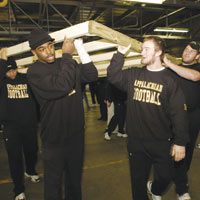NCAA News Archive - 2006
« back to 2006 | Back to NCAA News Archive Index
|
Special to The NCAA News
The mid-December afternoon before Appalachian State University defensive end Marques Murrell pounded on opposing players in his team’s Division I-AA Football Championship game win, he and his teammates pounded nails.
No, the Mountaineers weren’t moonlighting or doing an old-school workout. This pounding helped construct a house still far removed from its own yard, somewhere on the hurricane-ravaged
“This project is helping people get into houses who otherwise couldn’t,” Murrell said. “Coach (Jerry Moore) suggested we do it after the championship luncheon and the players were up for it. We put some boards together and helped put up some walls.”
The work helped kick off the NCAA’s three-year partnership with Habitat for Humanity International (HFHI), which was announced last October. The finished “home in a box” was trucked to the
The partnership’s stated mission is to “mobilize the NCAA’s national Student-Athlete Advisory Committees in all three divisions, and member coaching associations, to help provide volunteer support to build houses for families in need of decent, affordable housing.”
Four specific goals are embedded within that mission:
n Engage NCAA members through volunteer activities on Habitat builds with student-athletes and coaches;
n Affect society by building houses for the hurricane-relief efforts;
n Grow brands through co-branding activities around NCAA championship events and other public relations activities; and
n Create value via cost-effective management of respective efforts and through creative fund-raising at events.
Doug Harper, regional development director for Habitat International — who, like Murrell and Lawrence, was on site at the
“The thing we were most pleased about was how well the NCAA, the American Football Coaches Association, the
Grant Teaff, executive director of the AFCA, said that organization looks forward to helping with such projects in the future.
“This is a concrete way to help people rebuild their lives,” he said. “There’s no way that any organization can supply all that’s needed (on the
This rare teaming of two nonprofit groups is the only one of its type that HFHI has forged. It’s known as “NCAA Home Team,” a description that comfortably combines major themes of both organizations. The partnership began with a $1 million lead gift from Division II and a matching gift of $500,000 from the NCAA national office. Last month, the NCAA Executive Committee approved a $1 million allocation in Association-wide funds to be donated toward NCAA Home Team. Additional voluntary funds will be collected at all 88 national championships.
NCAA President Myles Brand said that such harnessing of NCAA resources on a national level gives a whole new meaning to the term “team building.”
“This effort provides a lasting contribution by working toward a larger, more effective, affordable and attainable housing solution,” Brand said.
Harper said the NCAA and Habitat International are similar in many ways, pointing out that HFHI works with 1,700 local affiliates within the
Mark Pope, associate director of athletics at
“They are a great idea,” Pope said. “It doesn’t take a tremendous amount of knowledge (for volunteers to make one). Everything is precut and labeled. If you can swing a hammer, you can do it.”
Figuring out who gets the finished products, which span 1,100 square feet (including three bedrooms and two bathrooms) and take about 2,000 man-hours to complete, follows much the same path as deciding who gets a traditional Habitat house.
“Those
Getting land for the houses is the major hurdle now — 65 kits are assembled and waiting, Harper said.
The next build will be a home in a box done in conjunction with the Division II Men’s and Women’s Swimming and Diving Championships hosted by the
A traditional Habitat home will be built in the city the following month. Although plans have not yet been finalized, a Habitat project is in the works for the Women’s Final Four in
Harper would like the partnership to become even stronger through the next few years.
“We are looking at how the NCAA and Habitat can create a legacy,” he said. “We know the NCAA focuses on student-athletes. We know Habitat focuses on eliminating substandard housing. We know there is a correlation between better education and better housing. We want to figure out how we can get these things to feed off of each other.
“We applaud the NCAA for recognizing that and for giving us this opportunity.”
It’s a home team even visitors can root for.
Habitat involvement
NCAA student-athletes interested in volunteering with Habitat for Humanity have a number of options.
They include Collegiate Challenge, a year-round program in which college groups work with a Habitat for Humanity affiliate and build a house over a one-week time frame. That can be done over spring break, summer or other times of the year. Participants pay a fee to help cover their lodging and meals.
To learn more about Collegiate Challenge or to register, go to www.habitat.org/ccyp/col_chal/default.asp. When registering a team, include “NCAA” in the team name so the NCAA can track student-athlete involvement in the partnership.
Another option is to join a campus chapter of Habitat for Humanity (or start a chapter if one does not exist on campus). The campus chapter program is a student-led, student-initiated organization on a college campus, which partners with the local Habitat for Humanity affiliate to fulfill the four functions of a campus chapter.
The four functions of campus chapters are building, fund-raising, advocating and educating. For information on that program and to sign up, go to www.habitat.org/ccyp/campus_chapters/default.aspx.
For additional information on student-athlete involvement with Habitat programs, contact Melody Lawrence, NCAA associate director of community relations, at mlawrence@ncaa.org, or Desiree Adaway, Habitat director of campus chapters and youths department, at dadaway@habitat.org.
© 2010 The National Collegiate Athletic Association
Terms and Conditions | Privacy Policy

